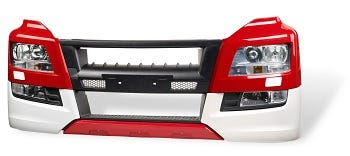Bumpers for trucks and heavy goods vehicles are being increasingly manufactured from thermoplastics. Unlike previous models, these bumpers are no longer produced as a single piece from sheet molding compounds (SMC). Instead, they are manufactured on a modular basis from several components, consisting of, for example, polyamide and polyester compounds from Lanxess (Leverkusen, Germany). This reportedly enables easier repair.
April 15, 2013
Bumpers for trucks and heavy goods vehicles are being increasingly manufactured from thermoplastics. Unlike previous models, these bumpers are no longer produced as a single piece from sheet molding compounds (SMC). Instead, they are manufactured on a modular basis from several components, consisting of, for example, polyamide and polyester compounds from Lanxess (Leverkusen, Germany). This reportedly enables easier repair.
|
Truck maker turns to modular design for multi-functional |
|
"The big advantage of our thermoplastics is that they offer greater design freedom and higher surface quality than SMC. They are also tougher and easier to coat. In addition, the parts do not require any post-finishing," explains Jürgen Horstmann, Key Account Manager for the truck industry at Lanxess.
The bumpers for TGX and TGS series trucks from MAN Truck & Bus AG (Munich, Germany) are molded by MEI Liberec, a production site of the Magna Exteriors & Interiors (MEI) Group located in Liberec, the Czech Republic. The bumper systems for the TGL and TGM series, meanwhile are made by Werkzeugbau Karl Krumpholz GmbH & Co.KG - Kunststofftechnik (Redwitz, Germany).
The headlamp supports of all four model series are made of Durethan DP BKV 60 H2.0 EF, a highly reinforced polyamide 6 with 60% glass fibers. The supports hold the headlamps and the light strips. They not only have to bear their weight—which, in the case of the TGX and TGS trucks, together amounts to around 8.5 kg per headlight—they must also withstand very high static and dynamic loads. For instance, they must not fracture even under severe dynamic acceleration of up to 10 times the force of gravity. "Our high-tech material can meet these specifications over a wide temperature range in all relevant climates due to its very high stiffness, strength and damping," says Horstmann. The high stiffness of polyamide 6 helps ensure that there is no fluttering of the headlamps when driving in the dark.
The U-shaped center front step of the TGX and TGS, which is connected to the headlamp supports, is injection molded from the PET+PBT blend Pocan TS 3220, reinforced with 20% glass fibers. The part is provided with numerous ribs and designed for a static load of 2 kN, because it has to bear the weight of the driver as he climbs on to the front to clean the windscreen. "Our blend has adequate flexural stiffness for this, making steel reinforcement unnecessary. Apart from that, it produces optically perfect, UV and weather-resistant surfaces that are easy to coat," says Horstmann.
The center front step for the TGL and TGM, on the other hand, is made of highly reinforced Durethan DP BKV 60 H2.0 EF. What was needed was a very strong and rigid material that also has outstanding dynamic load strength. After all, these vehicles spend a lot of their time driving around on building sites. The step is partly concealed by other components and in visible areas is provided with a cover of Pocan C 1206. "This unreinforced PET+PC blend is noted for its good surface quality and its excellent UV and weather stability. The cover can therefore be used either with or without a coating," said Horstmann.
With the bumpers of the TGL and TGM series, both the center cover and the headlamp covers are made of Pocan C 1206. Here, the PET/PBT blend material is noted for its low shrinkage, high heat resistance and good low-temperature impact strength. It also produces dimensionally resistant parts. Further, the good surface quality and UV and weather resistance mean that the parts can also be used without coating. The side covers of the headlamp supports must be easy to disassemble to ensure quick and easy lamp changes. A single-shell design with ribs and retainers on the back would have led to unsightly marks on the visible surfaces. For this reason, the covers were designed with twin walls and also fitted with a fixing frame of Pocan C 1206 using ultrasonic welding. "This is where the excellent weldability of our blend pays off," says Horstmann.
About the Author(s)
You May Also Like




